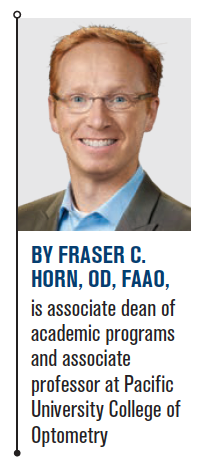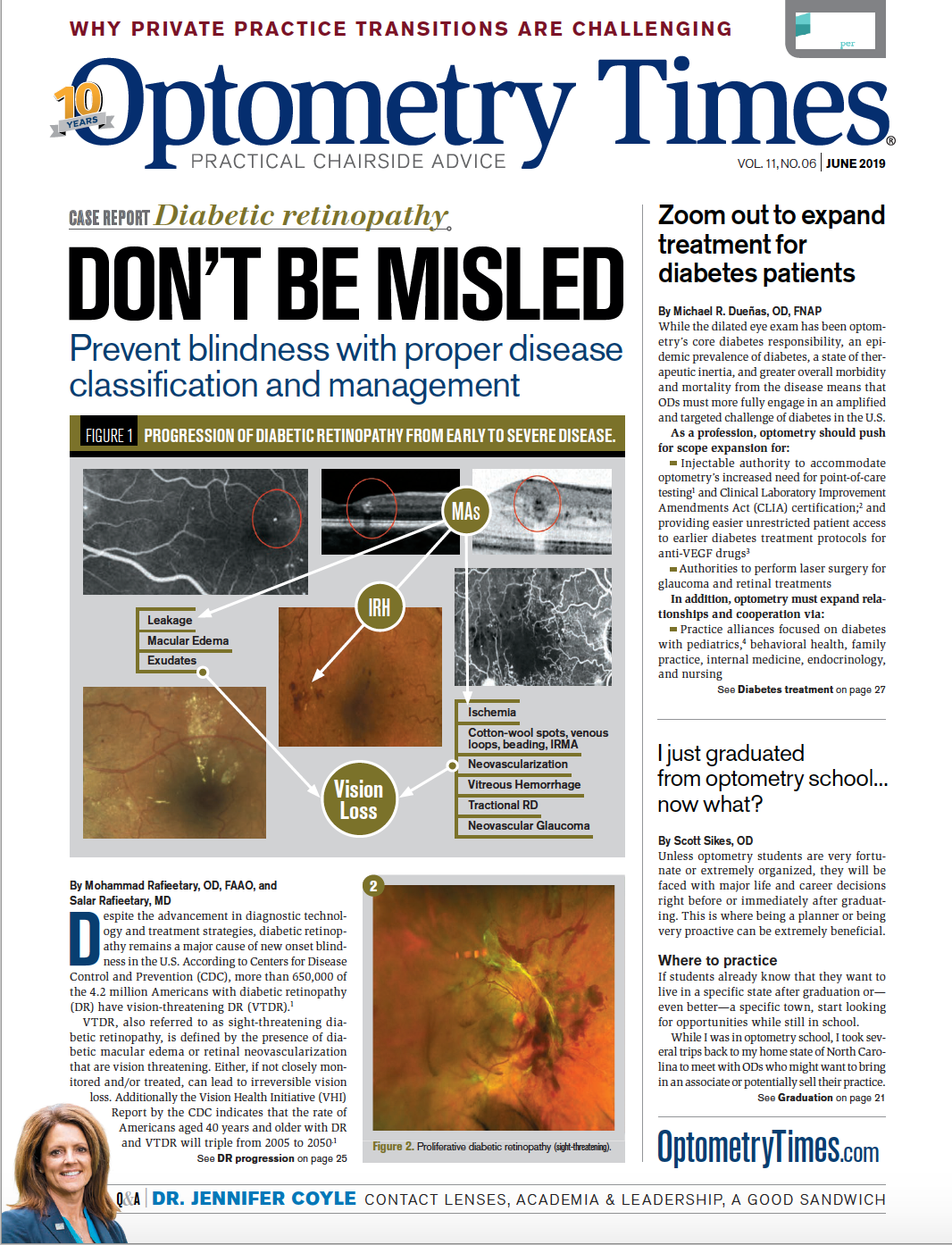3 mental heath conditions to watch for in patients


I challenge everyone to ask your patients a few more questions during an exam. Specifically, screen for mental health concerns and make it part of optometry’s systemic disease investigation.
In 2016, the National Institute of Mental Health (NIMH) reported that approximately 18.3 percent of adults in the U.S. had a mental illness.1 Furthermore, only 44 percent of those with mental illness received treatment.2 This means about 1 out of 10 patients may have a mental health condition that is not diagnosed or being treated.
Even more alarming are the statistics for adolescents. A recent study in England found that 23.9 percent of women aged 17 to 19 were likely to have a mental disorder, specifically depression and anxiety.3,4 This statistic is double that of men of the same age group. According to NIMH there is a 49.5 percent lifetime prevalence of any mental disorder among those age 13-18.1
Unfortunately, there is a shortage of mental health care providers, so primary-care physicians are needing to screen more frequently.2,5,6
ODs get to know patients and provide treatment recommendations that are influenced by the patient’s circumstances. Therefore, ODs can make a difference by screening for mental health conditions. If left untreated, mental health illnesses can impact patients’ quality of life and their ability to be and feel productive and can ultimately lead to death.
Related: ODs must examine more than just eyes
Depression
There are multiple types of depression; however, this article addresses persistent depressive disorder, or clinical depression. This is defined as “a depressed mood that lasts for at least two years.”7
Symptoms may include, but are not limited to:7
• Persistent sad, anxious, or “empty” mood
• Feelings of hopelessness, or pessimism
• Irritability
• Feelings of guilt, worthlessness or helplessness
• Loss of interest or pleasure in hobbies and activities
• Decreased energy or fatigue
• Moving or talking more slowly
• Feeling restless or having trouble sitting still
• Difficulty concentrating, remembering or making decisions
• Difficulty sleeping, early-morning awakening, or oversleeping
• Appetite and/or weight changes
• Thoughts of death or suicide, or suicide attempts
• Aches or pains, headaches, cramps or digestive problems without a clear physical cause and/or that do not ease even with treatment
This list includes “classic” symptoms like hopelessness, loss of interest, and so on; however, approximately 70 percent of patients with depression present with somatic complaints.8 These somatic symptoms are much more socially acceptable yet can also delay the diagnosis of depression because physicians are looking for the cause of the somatic concerns, not the mental aspects.
Somatization is not necessarily a coping mechanism but a true sensation related to the depression. Pain and depression share common biological pathways, specifically with serotonin and norepinephrine.9
Multiple tests can screen for depression.
Related: How to help patients who are depressed
The first test is the Patient Health Questionnaire-2 (PHQ-2).10Any positive response will require that physicians administer the Patient Health Questionnaire-9 (PHQ-9). The PHQ-2 has a low specificity for depression; however, the PHQ-9 has a much higher specificity. The PHQ-9 will take two to five minutes to administer, and many doctors will print the form for the patient to fill it out, which may allow the patient to provide candid responses.
The screening result may provide a way to start the discussion on consulting a mental healthcare or primary-care provider. In addition, discussing the link of depression to physical complaint should be stated clearly. Some ways to help these interactions is to give the patient adequate time, demonstrate good listening skills, and provide empathetic responses.
Be aware of any suspicions of suicidal tendencies. Suicide is the tenth leading cause of death in the United States and the second leading cause of death in those 10–34 years old.11
If an OD suspects that a patient has suicidal tendencies, ask her if she has considered hurting herself or asking if she is safe. If there are immediate concerns, call 911. In addition, patients can call the National Suicide Prevention Lifeline at 1-800-273-TALK (8255).
Read more about patient care
Anxiety
Anxiety is defined as fear and related behavioral disturbances in anticipation of a future threat. Individuals with anxiety will typically overestimate the danger in situations. Fear, on the other hand, is the emotional response to a real or perceived imminent threat.12 Anxiety may develop in childhood and is more common in females at almost a 2:1 ratio.12
General anxiety disorder (GAD) may be diagnosed when an individual finds it difficult to control excessive worry and when this worry can impact function. Most ODs have experienced patients who have anxiety for certain procedures. The anxiety response is often reduced by good patient education on what will occur and empathetic listening. With GAD, the anxiety can be a larger concern, and the patient may avoid necessary eye care and/or other areas of support.
Similar to depression, there is a screening tool for GAD called the GAD-7. This is a series of questions regarding different symptoms over the prior two weeks.13 Again, providing patients time to answer the questions by themselves may provide more earnest answers. Scores of 10 or above have a good sensitivity and specificity. For those with greater scores, there is a correlation with functional impairment.14 Similar to depression, providing a safe environment in the office and giving the patient time is critical for a productive interaction.
When it comes to treatment for anxiety, psychotherapy and pharmaceutical therapy are effective. Additionally, exercise can be an effective, inexpensive way to help with management. Exercising at 60 percent to 90 percent of maximal heart rate for 20 minutes for three times per week shows a benefit. The same effect is also seen with yoga. A change in diet and better sleep may also be helpful.15
Related: Diet, exercise can diminish eye diseases
Dementia and Alzheimer’s
Dementia is an overall term that describes loss of cognitive function and behavioral abilities that reduce a person’s ability to perform daily life activities.16,17 Dementia is caused by damage to brain cells and different conditions can cause this. Alzheimer’s disease (AD) is the most common cause of dementia.16,17
There are over 46 million people in the world living with AD, and this number is expected to rise to 131.5 million by 2050.18
Alzheimer’s disease is caused by a buildup of beta-amyloid in the synapses between nerve cells. In addition, fibers of protein, called tau, build up inside cells.17 Due to the impact on the brain’s function, inflammation is triggered by the body’s immune system, and the cells eventually die. This cell death impacts function of the individual, and this can eventually lead to death.17
One of the first symptoms of AD is difficulty remembering newly learned information. Symptoms progress to:17
• Eventual disorientation
• Mood changes
• Confusion
• Behavior changes
• Difficulty speaking, walking, swallowing.
Because of the slow progression, these changes are not obvious to those living with the individual.17 Early diagnosis is very helpful when it comes to treatment.
Related: New concepts in diagnosis and treatment
Diagnostic tests are traditionally subjective in style, so research is focused on objective diagnostic tests. Currently, there is a great deal of attention on ocular signs-specifically, how ocular coherence tomography (OCT) of the retina may provide an early diagnosis.
One study showed a reduction in the mean retinal nerve fiber layer (RNFL) in all four quadrants around the macula in those with AD. In addition, those with mild cognitive impairment (MCI) had decreased RNFL thickness compared to controls.18
Another study, which had a small number of participants, identified biomarkers for AD in positron emission tomography (PET) and computed tomography (CT) scans. Those with positive biomarkers tended to have smaller inner foveal thickness (66 µm vs. 75.4 µm) and a larger foveal avascular zone (0.364 mm2 vs 0.275 mm2).19
More research will be published on this topic, and the results will likely shape our practices in the near future.
Related: Alzheimer's disease and dementia impacted by diabetes
Two investigational ophthalmic tests for AD show promise. One is from NeuroVision which uses curcumin to attach to the beta-amyloid in the retina that then identifies fluorescence with their instrument.
Another
type of test (Cognoptix, Inc) uses a laser-scanner to detect beta-amyloid in the lens.20 Both of these have a high specificity for AD.
Subjective tests can be performed for MCI. One is the Mini-Mental State Exam (MMSE) or Folstein test that takes about 10 minutes and can be found online.21
Another recent study measured reaction time to visual, auditory, and auditory-visual stimuli.22 This study shows two things may occur in patients with MCI: a shift from the dominant visual sense to an auditory dominant stimulus response combined with a slower reaction time to audio-visual stimuli when compared to healthy young individuals and healthy older individuals.
More research needs to be conducted; however, this study shows promise to identify MCI earlier via a simple audio and visual stimuli reaction test.
Related: ODs' role promising in detecting Alzheimer's disease
The clock-drawing test requires the patient to draw a circle, label the numbers of a clock, then draw the hands to point at “10 minutes past 11.” This test is able to be administered quickly and can be a good screening for cognitive function.23
Treatment for dementia is currently focused on maintaining memory. The use of cholinesterase inhibitors is commonly used; specifically, donepezil, revastigmin, and galantamine. These are prescribed in early to moderate stages. For later stages, memantine is often prescribed to help with memory, attention, resonsing, language, and the ability to perform simple tasks.24
Keep a watchful eye
Optometrists are tasked with assessing for systemic concerns as part of the care for patients. By screening for common mental health disorders, ODs may be making a significant impact on a patient’s life-possibly even saving it. The challenge to all ODs is to incorporate these screenings into the care of all patients.
Read more patient care articles here
About the author
Dr. Horn is a past chair of the American Optometric Association’s Sports Vision Section and is a current member-at-large of the AOA Sports and Performance Vision Committee. He works with amateur and professional athletes from multiple sports and has lectured internationally on sports vision and primary-care optometry. Dr. Horn graduated from Pacific University College of Optometry and completed a residency in primary care and ocular disease at the Perry Point VA hospital. He is a co-founder of Sports Vision Pros LLC, an interprofessional online community dedicated to informing everyone about the role of vision and performance. Dr. Horn has been a paid speaker for Sanofi Genzyme.
hornfc@pacificu.edu
References:
1. National Institute of Mental Health. Mental Illness. Available at: https://www.nimh.nih.gov/health/statistics/mental-illness.shtml. Accessed 5/13/19.
2. Mental Health America. The State of Mental Health in America 2017. Available at: http://www.mentalhealthamerica.net/issues/2017-state-mental-health-america-report-overview-historical-data. Accessed 5/13/19.
3. Triggle N. Mental health: One in four young women struggling. BBC News. Available at: https://www.bbc.com/news/health-46295719. Accessed 5/13/19.
4. National Health Service. Mental Health of Children and Young People in England 2017. Available at: https://digital.nhs.uk/data-and-information/publications/statistical/mental-health-of-children-and-young-people-in-england/2017/2017. Accessed 5/13/19.
5. Vermani M, Marcus M, Katzman MA. Rates of detection of mood and anxiety disorders in primary care: a descriptive, cross-sectional study. Prim Care Companion CNS Disord. 2011;13(2): pii: PCC.10m01013.
6. Cano A, Sprafkin RP, Scaturo DJ, Lantinga LJ, Fiese BH, Brand F. Mental Health Screening in Primary Care: A Comparison of 3 Brief Measures of Psychological Distress. Prim Care Companion J Clin Psychiatry. 2001 Oct;3(5):206-210.
7. National Institute of Mental Health. Depression. Available at: https://www.nimh.nih.gov/health/topics/depression/index.shtml. Accessed 5/13/19.
8. Tylee A, Gandhi P. The importance of somatic symptoms in depression in primary care. Prim Care Companion J Clin Psychiatry. 2005;7(4):167-76.
9. Han C, Pae CU. Pain and depression: a neurobiological perspective of their relationship. Psychiatry Investig. 2015 Jan;12(1):1-8.
10. Maurer DM. Screening for Depression. American Family Physician. Available at: https://www.aafp.org/afp/2012/0115/p139.html. Accessed 5/13/19.
11. National Institute of Mental Health. Suicide. Available at: https://www.nimh.nih.gov/health/statistics/suicide.shtml. Accessed 5/13/19.
12. Psychiatry Online. Anxiety Disorders. Available at: http://dsm.psychiatryonline.org/doi/full/10.1176/appi.books.9780890425596.dsm05. Accessed 5/13/19.
13. Maurer DM. Screening for Depression. American Family Physician. Available at: https://www.aafp.org/afp/2012/0115/p139.html. Accessed 5/13/19.
14. Spitzer RL, Kroenke K, Williams JB, Löwe B. A brief measure for assessing generalized anxiety disorder: the GAD-7. Arch Intern Med. 2006 May 22;166(10):1092-7.
15. HelpGuide. Generalized Anxiety Disorder (GAD). Available at: http://www.helpguide.org/articles/anxiety/generalized-anxiety-disorder-gad.htm. Accessed 5/13/19.
16. National Institute on Aging. What Is Dementia? Available at: https://www.nia.nih.gov/health/what-dementia. Accessed 5/13/19.
17. Alzheimer’s Association. What Is Alzheimer’s. Available at: https://www.alz.org/alzheimers-dementia/what-is-dementia. Accessed 5/13/19.
18. Javaid FZ, Brenton J, Guo L, Cordeiro MF. Visual and Ocular Manifestations of Alzheimer’s Disease and Their Use as Biomarkers for Diagnosis and Progression. Front Neurol. 2016 Apr 19;7:55.
19. O'Bryhim BE, Apte RS, Kung N, Coble D, Van Stavern GP. Association of Preclinical Alzheimer’s Disease With Optical Coherence Tomographic Angiography Findings. JAMA Ophthalmol. 2018 Nov 1;136(11):1242-1248.
20. NBC News. Worried You May be Developing Alzheimer’s? Check Your Eyes. Available at: http://www.nbcnews.com/health/aging/worried-you-may-be-developing-alzheimers-check-your-eyes-n153226. Accessed 5/13/19.
21. Rosenzweig A. Overview of the Mini-Mental State Exam for Alzheimer’s. verywellhealth. Available at: https://www.verywellhealth.com/mini-mental-state-exam-as-an-alzheimers-screening-test-98623. Accessed 5/13/19.
22. Murray MM, Eardley AF, Edginton T, Oyekan R, Smyth E, Matusz PJ. Sensory dominance and multisensory integration as screening tools in aging. Sci Rep. 2018 Jun 11;8(1):8901.
23. Heerema E. How the Clock-Drawing Test Screens for Dementia. verywellhealth. Available at: https://www.verywellhealth.com/the-clock-drawing-test-98619. Accessed 5/13/19.
24. Alzheimer’s Association. Medications for Memory. Available at: https://www.alz.org/alzheimers-dementia/treatments/medications-for-memory. Accessed 5/13/19.

Newsletter
Want more insights like this? Subscribe to Optometry Times and get clinical pearls and practice tips delivered straight to your inbox.